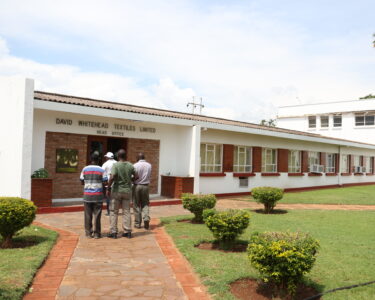… First cannabis farm and factory in Africa opens in ‘Mash Best’ province
With the right understanding by the authorities, Zimbabwe’s economy could benefit immensely from the export of copious metres of fabric made from industrial hemp, that is if the crop is understood and allowed to be grown in the country on an industrial scale, much like maize and wheat and soya beans and all the other crops are grown in Zimbabwe, reports Baffour Ankomah.
Currently, countries like China (the largest exporter of Industrial hemp fabric), which have understood the crop, are not only enjoying the benefits of the super fibre that industrial hemp produces, but also the financial rewards that the value chain brings. This realisation has recently dawned in the “Mash Best” province of Zimbabwe, in Nyabira to be precise, where President Emmerson Mnangagwa commissioned a cannabis farm and plant on 11 May 2022, owned by an investor called Swiss Bioceuticals from Switzerland.
To avoid confusion in this article, we will call the “plant” the factory to distinguish it from the “plant” as in cannabis.
The main aim of the cannabis farm and factory in Nyabira is to produce medicinal cannabis and process it into CBG oil. CBG or Cannabigerol is a cannabinoid, a “naturally occurring compound derived from plants”, says the medical literature.
According to the Alcohol and Drug Foundation (ADF), founded in 1959 in Melbourne, Australia, “the word cannabinoid refers to every chemical substance, regardless of structure or origin, that joins the cannabinoid receptors of the body and brain and that have similar effects to those produced by the Cannabis Sativa plant.”
ADF goes on: “The three types of cannabinoids that people use are recreational, medicinal and synthetic. Research has found that the cannabis plant produces between 80 and 100 cannabinoids and about 300 non-cannabinoid chemicals. The two main cannabinoids are delta-9-tetrahydrocannabinol (THC) and cannabidiol (CBD).
“The most commonly known of the two is delta-9-tetrahydrocannabinol (THC), which is the chemical that is responsible for the psychoactive effects of cannabis.
“The main difference between CBD and THC is that THC has strong psychoactive effects, meaning it makes a person ‘high’, whereas CBD is thought to have an anti-psychoactive effect that controls or moderates the ‘high’ caused by the THC. CBD is also thought to reduce some of the other negative effects that people can experience from THC, such as anxiety.”
‘The mother of all cannabinoids’
According to the California-based skincare manufacturer, Terasana Clinical, CBG “is actually the acidic form and ‘parent’ molecule of the other main cannabinoids (ie, CBD and THC). CBG has been famously coined as, ‘the mother of all cannabinoids’. That means THC and CBD (along with all other cannabinoids) can’t exist without the initial formation of CBG in its raw form. This does not mean, however, that CBG contains THC or CBD.
“In order for CBG to become something else, it must convert its raw, acidic form into CBD and THC. If the CBG is extracted prior to that conversion, it remains pure and potent with no psychoactive properties present. This creates an incredible opportunity for a healing plant without the legal implications of psychoactive side effects.”
The medical terminologies can be confusing, so let’s stay on the straight and narrow. According to medical experts, CBG oil fights cancer-causing cells, reduces inflammation, fights bacteria infections, calms irritation and redness, helps supplement a healthy appetite, and supports some of the body’s essential functions for optimal health.
In Zimbabwe where cancer has become one of the highest causes of death in recent years, CBG oil can become a national security issue which the government can keenly take up. But fog created by ignorance and a high misunderstanding that has led to the stigmatisation of cannabis, means no one is ready to take a proper look at this misunderstood crop. Maybe the commissioning of the cannabis farm and factory in Nyabira by President Mnangagwa will be the elixir that changes things for the production of CBG oil in Zimbabwe.
Amazingly, for all the stigmatisation of cannabis, today, as Terasana Clinical cares to point out, “cannabis plants are not the only way to produce and extract cannabinoids [which are now] actively being found in other plants and sustainable production sources like carrots, citrus, and ginger. Also, after years of development and biotechnology, the sugarcane plant has become an incredible and sustainable source for CBG.”
Terasana Clinical routinely uses CBG extracted from sugar cane in its skin care products sold worldwide.
How CBG works
According to Terasana Clinical, “CBG works perfectly in the human body because it fits into the framework of how our endocannabinoid system functions. CBG molecules link with the cannabinoid receptors our bodies already use to regulate many processes.
“The endocannabinoid system in the human body is wildly important for regulating brain function, endocrine function, and immunity. It also actively assists in the secretion of hormones related to reproductive functions and stress, among other things. CBG molecules interact with the cannabinoid receptors already present in the human body to optimise performance and regulate healthy functions.”
Terasana continues: “Like some other cannabinoids, CBG is completely legal, provided that it is derived from a cannabis plant that contains less than 0.3% THC. THC has psychoactive effects and is the most important factor in legality because it contains psychoactive properties that are potent above 3.0%. So CBG is only illegal if it is derived from a hemp plant containing more than 3.0% THC.
“And here’s the deal: a hemp plant containing more than 0.3% THC is designated as marijuana. Yet marijuana is considered a controlled substance in many countries and in the US under the Controlled Substance Act, which has legal implications.
“So you will want your CBG to be derived from a source containing less than 0.3% THC, which shouldn’t be too hard to find, especially since you can find extracts of CBG in other sources, such as sugarcane, which has now taken THC and psychoactive properties out of the picture, for a simplified healing and nourishing solution – the way nature intended.
“At Terasana, we have formulated a revolutionary process through sustainably-sourced sugarcane fermentation to create pure, clean, and functional CBG. Zero legal implications, all the benefits of a cannabinoid compound. It’s a game-changer.”
More education on CBG
According to other experts: “CBG and CBD have different molecule structures, neither of which have psychoactive properties, unlike THC. CBG is the original source of CBD but can be extracted before it is synthesised into CBD. So why choose CBG over CBD? It is commonly argued that CBG is more powerful since it is a precursor to all other cannabinoids. People want results, and CBG delivers.
CBG also boasts a wide range of skincare benefits and both mental and physical benefits too. Stress, anxiety, and depression are all known to take a large toll on physical and mental wellbeing. CBG oil could be the tool that finally helps naturally to treat and relieve mental health concerns.
Also studies show “the effectiveness of CBG in reducing inflammation in irritable bowel syndrome (IBS) or inflammatory bowel disease, something millions of people struggle with in today’s society. In a study conducted with mice, significant data concluded that CBG had a positive effect on the symptoms and conditions associated with inflammatory bowel disease. Other studies also show CBG’s ability to fight nausea, stimulate appetite, and regulate sleep.”
However, CBG is expensive to extract and produce. “Since it is derived in the early stages of the plant life of hemp, harvesting becomes expensive,” the experts say. “You have to spend time, labour, and money to plant more cannabis plants, harvest them early, trash the remains, and start over. Plus, you are only able to extract a minuscule amount of CBG from each plant since the plant is not fully developed. As such only 1% of the plant contains CBG.”
Alternative medicines
The above is the challenge that faces the cannabis farm and factory in Nyabira. The farm and factory’s main aim, according to Farai Paruwani, the factory supervisor, is to process medicinal cannabis into CBG oil.
Yvonne Mashayamombe, the factory’s quality representative, adds that “the vision is to produce medicines that are complementary and alternative to the conventional ones. Cannabis is clean and has multiple uses. Turning it into oil is one of the first steps we think can help people who need it.”
Mashayamombe went on: “Cannabis is thought to alleviate symptoms related to mostly the terminal diseases like cancer and other debilitating ones like Alzheimer’s, seizures, and so forth. It alleviates symptoms of all those diseases.”
According to her, cannabis medication has not received its rightful recognition globally because of suppression. “All over the world, people stigmatise cannabis but now the world is opening up to the opportunities that it can cure diseases,” she said. “It was suppressed but now people are accepting it for what it is and controlling the way it is cultivated, how it is processed, and the whole supply chain, and trying to make it better.”
Thankfully, the Swiss-owned company, Swiss Bioceuticals, decided to invest in CBG oil production in no other African country than Zimbabwe and Mashonaland West Province where it considered the climatic conditions conducive for the production of cannabis, and also the opportunity of the government legalising the growing of cannabis.
The Bioceuticals cannabis factory is the first in Africa and the seventh in the world. Its cannabis farm covers 6 hectares. “This is the initial stage, next year some more stages are coming,” Paruwani told the Brick by Brick.
The cannabis seeds are imported. When harvested, the cannabis flowers or buds are processed to produce crude, the oil that is later turned into a concentrate, which is exported mainly to the US, where it is converted to finer, commercially available products like capsules and tablets.
We just produce the raw material here,” Mashayamombe told the Brick by Brick. “Further down the chain, people would want to refine it, add perfumes and flavours. Here we just produce the crude and sell the crude outside the country because in Zimbabwe, cannabis was only recently allowed to be registered as medicine.
According to Paruwani, the factory follows international requirements in the processing of the concentrate. “The US does this at a very large scale. This [factory] is one year old after commissioning, so we haven’t produced much, we have done about 5,000 kg of the concentrate from May 2002 to mid-November 2022.”
Asked if it was good business and worth their while, Paruwani replied: “Yes it is, I think it is. From the way we are doing it, the quality of the product that we get, the steps that we use, and all the processes, I believe it is a very good business which has a very bright future.”
The Nyabira farm
The editors of Brick by Brick were taken around the cannabis farm by Johannes Swan, the head grower, a man who knows his cannabis, sorry stuff. He said they started building the project about two-and-a-half years ago, but they had only been growing cannabis for a year-and-a-half now. “But so far, so good, we’ve been seeing excellent progress with the varieties that we bring in and grow,” he added.
He showed the Brick by Brick editors the planting room where everything starts, where the seeds are nursed in trays and later transplanted in green houses covering 6 hectares of the farm.
Two of the challenges facing the farm are pests (including rats, mice and crickets who love cannabis and eat the young plants), and humidity. “Winter is the best time to grow,” Swan told the Brick by Brick. “In the summer because of the high humidity levels, there is constant rain and damp conditions, so we get a lot of fungus and disease, which are extremely difficult to deal with, using just biological treatments.”
He explained that they had to grow the cannabis as organically as possible. “We are not allowed to use any chemicals, so we use biological agents or beneficial fungi and bacteria which we apply to kill the bad fungi and bacteria as well as control the pests.”
But they use “some of the best fertilisers from the world – from Germany, Israel, Sweden – very high quality, soluble fertilisers,” Swan said, noting that the plant needs care because it is a difficult crop.
“When they mature and closer to harvest, they naturally start to die. The flower or the bud is full of oil, very sticky, and it is the oil that we are extracting,” Swan explained. “This variety [in their greenhouses] does not have enough THC. All the varieties we have tried, none of them has THC higher enough or above 0.3%, so you cannot get high from this. You only become high when the THC is 3.0% and above. So you can smoke this whole field and it will not make you high because the THC is less than 0.3%.”
In the cannabis factory, he said, “they are producing what is called the full spectrum oil or full spectrum powder, which has plenty of the different cannabinoids in it. It goes for further processing overseas but I don’t know where exactly”.
Swan went on: “In harvesting the crop, the leaves become waste. The stalks are waste. What we are looking for is the flower or the bud. The leaves have no oil, there is nothing there. All the potency comes from the flowers because that is where the oil is.
“The plants here are all female. You don’t want any males because as soon as the pollination stage begins, they lose a lot of the good stuff, and the cannabis oil decreases significantly. So any males we find, they are culled immediately. Our workers are trained to spot the males by sight.”
Industrial hemp
Swan then took the Brick by Brick editors through the other beneficial uses of cannabis. He talked about China where hemp has been grown for hundreds of years for medicine, and the stalks used to manufacture fabric for clothes.
“I used to have a clothing company that used to make clothes from industrial hemp stalks,” Swan disclosed. “Industrial hemp is produced using less water than cotton and no herbicides. So at the end of the day, it is a lot cheaper to produce than cotton, and you can get four times more fibre per hectare than you get from a cotton crop. And it is a lot stronger and lasts longer. It is UV absorbent and anti-microbial, and so it is excellent. Elsewhere in the world, they use it for hospital bedding, hospital gowns and sheets.”
More importantly, industrial hemp can also be grown outdoors as farmers do in high- population plants like maize. “You can have 80,000 to 100,000 plants per hectare,” Swan explained, “and actually you get the best fibre when you harvest them just when they start to flower.
“You can build houses with it, and in fact people in the UK are doing it to save on heating costs. These are houses whose inner core is built from industrial hemp. It naturally controls the temperature in the room.”
Zimbabwe’s cannabis regulations
Turning to the crop in his green houses, Swan said: “These ones here you can call hemp or cannabis or marijuana, but it is what is in the flower that determines it. That is where the difference comes in. It is dependent on the country’s regulations. Zimbabwe is 0.3% THC, and a lot of people are pushing for 1.0%. In some places in the world, it is 1.0%, because users only become psycho-active when the THC is 3.0%. So anything under 3%, you cannot actually get high on.”
According to him, the Zimbabwean government should do more not only on public education about cannabis, but also to keep up the education within the government itself because many government officials have a deep misunderstanding of the crop and therefore put unnecessary barriers in the way of farmers who want to grow it.
“There is a massive barrier in terms of the licence, it is forty-something-thousand US dollars,” Swan disclosed. “Then the cost of the infrastructure. People could be growing this outdoors instead of growing it in greenhouses which cost a lot of money.
“At the moment, the cost of developing the supply chain, especially for industrial hemp, is also very expensive. David Whitehead Textiles, Kadoma Textiles and other textile manufacturers in the country are very, very interested in fibre from hemp, but because of the barriers to entry they are not jumping the way they should, especially at Kadoma Textiles where I spent quite a lot of time.
“So the government can really, really help in this matter. Zimbabwe can export fibre from industrial hemp after processing it locally, or even just exporting the raw material, and this can bring in a lot of foreign exchange for the country.”
Government support
Continuing on the theme of what the government can do, Swan said: “So far, we have had a lot of support from the authorities, there has been a give-and-take from both sides. The government can actually do so much, without putting in any money. That’s where they have been very, very helpful.”
Swan continued: “The regulatory authority came to us and admitted that they did not fully understand this crop and the market, ‘so help us, how should we regulate this’. It was a brilliant approach, I think. It is better to come to the farmer and the people who know the crop. Other farmers in the country are interested in growing it, but entry requirements are now so high and strict that the conditions are not attractive to farmers.
“As we speak, the regulations say you must have extreme fencing, extreme infrastructure and CCTV cameras [which make it look like you are going into a very high security area]. I have been given clear instructions that nobody should be allowed through the gates.
“They also want us to store footage from the security cameras initially for up to 5 years. The Dubai government stores the most footage in the world and that’s about 12 months. Here they are asking us to store 5 years of footage, and it is extremely expensive. Just 4 months’ worth of hard drives is US$6,000 plus. And with the licence issue, they want to make money from farmers even before they export anything. Everything is so, so expensive. There are very extreme barriers to entry.”
“However, in other areas, the authorities have been very helpful in terms of saying, “we are just going to give you time, we are not going to be exactly stringent on what the regulations say because you are still trying to build this basically”.
“Some of the regulations are almost like a non-starter, extremely difficult. But they have been working with us, working together, instead of bashing heads like it was a few years ago.”
The message
The point that Swan tried to make was that Zimbabwe too could become a major exporter of cannabis medicine and fibre or fabric from industrial hemp, if the government and its officials took time to understand the crop and allow it to be grown on a large scale like maize or wheat.
Globally, China produces approximately 70% of the world’s output of industrial hemp textile, though only a small portion of the hemp produced in China is made into fabric. The vast majority is made into fuel, paper, and other industrial products.
“France is the next largest producer of this crop followed by Austria, Chile, and the United Kingdom,” according to Sewport.com. “In all, over 30 countries around the world produce industrial hemp, and production of this crop in the United States is also on the upswing.
“The 2014 federal farm bill permitted cultivation of industrial hemp for research purposes on the federal level in the United States, and more and more states are taking matters in their own hands and growing this crop for commercial purposes without the explicit permission of the federal government. In most cases, the states pursuing this agricultural endeavour are those that have also legalised the use of recreational marijuana.”
Sewport.com goes on: “While many changes have occurred in the arena of hemp cultivation in modern times, this plant has been an integral part of human agricultural endeavours since before the dawn of civilisation. It is believed that this crop has been cultivated for medicinal purposes for at least 10,000 years, which means that it was one of the first plants to be cultivated by human beings.
“Notable figures in American history such as George Washington, Thomas Jefferson, and Andrew Jackson were all cultivators of hemp for industrial purposes, and it wasn’t until the 1930s that the cultivation of this crop became stigmatised in the United States. It is possible that major producers of paper and synthetic fabrics in America feared this textile’s competitive edge and unjustly tied this fabric to the intoxicant marijuana to make its cultivation taboo.”





